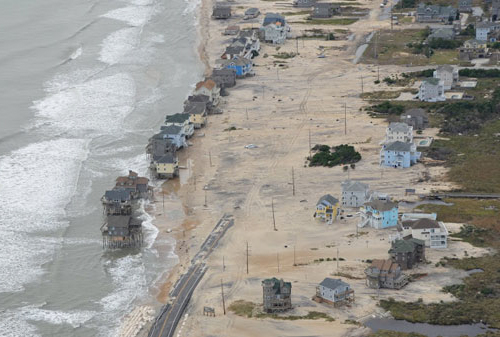Years of living dangerously leave beaches forlorn future

Painting by Numbers: A clear majority of Americans have now well-connected the dots between extreme weather events and global warming, thanks in large part to the ongoing drought, which will possibly prove the costliest ‘natural’ disaster in United States history. chart US Drought Monitor
In the last year, the tide of public opinion has turned. Americans now largely accept global warming as a clear and present danger, largely as a result of the record-breaking drought that is affecting most of the United States. A record minimum Arctic sea ice extent, in September, and hybrid hurricane Sandy—second-only costliest Atlantic storm to Katrina—has clinched the issue for a majority of westerners. Meantime the far deadlier Typhoon Bopha, which has left more than 1500 dead or missing, barely registers a ripple on western consciousness—life is cheap in the Philippines, at least in the mind of the media.
There is little doubt that if today’s voters could collectively picture the harsh and impoverished future they and their children will be forced to endure, politicians who demonstrated they shared that concern would experience overwhelming support. Storms come and go, all too soon forgotten by those not directly affected. However, the spectre that should serve to motivate the beach-loving billions, not least of all New Zealanders, is life without beaches.
The multi-metre sea-level rise that is probable this century will see most sandy beaches submerged for millennium. Some beaches will disappear in just decades, such as those backed by sea walls or cliffs. Others, where they are allowed to, will migrate inland for some time, particularly where beaches are backed by substantial, naturally vegetated dune systems. But ultimately beach migration will be no match for the non-linear sea-level rise that is resulting from the unprecedented power of fossil-fueled climate forcing. Much of the new coastline will be determinedly muddy, with mangroves offering welcome respite, where today they are callously cursed for causing muddiness. Professor Orrin Pilkey, Duke University, provides this sobering overview:

Sandy Aftertaste Foretaste: While inexorable sea-level rise will inevitably spell an end to current coastal communities, it is the extreme weather events such as Hurricane Sandy that will, with increasing frequency and ferocity, sound their death knell. photographer Andrew Coburn
Of all the various anticipated impacts of global climate change, sea level rise will likely be the first to produce a human catastrophe on a global scale. Heavily populated low-lying lands on deltas (e.g., The Ganges-Brahmaputra Delta) will be abandoned, displacing millions of people. Atoll nations in the Pacific (Tuvalu) and Indian Oceans (The Maldives) will disappear; major cities (Miami, Rotterdam, New York/Newark) will be building storm gates and abandoning the low-lying city fringes. Barrier islands lined with tourist facilities and high-rise buildings along the world’s coastal plains will either be abandoned or will be completely surrounded by massive sea walls. Development-lined beaches everywhere will be degraded and more than likely will be destroyed.
This stark future is imagined by few—hitherto civilisation has only ever experienced a stable sea level. It seems that future-fiction writers and mainstream movie makers are determinedly ignoring global warming, or where they attempt to it, to be incapable of portraying a remotely scientifically plausible scenario—while some of the extreme weather in store may make its recipients feel another ice age is on its way, the future is for an inexorably hotter, and increasingly unliveable, climate.
While the world waits for the big names in and out of Hollywood to pull their weight in telling the world’s greatest story, documentary makers are doing immeasurably better. Testament to cinematic courage Chasing Ice will begin screening in the United Kingdom on Friday. What it lacks in blood compared to the producers’ epic The Cove, it makes more than up for in guts. Next year a documentary series will première with the largely self-explanatory title Years of Living Dangerously, featuring Arnold Schwarzenegger and Matt Damon. Executive producers include Schwarzenegger and James Cameron, with physicist and editor of Climate Progress Joseph Romm to keep them on the scientific straight and narrow:

Living Dangerously: Matt Damon—star and co-writer of hard-hitting movie Promised Land, which opens in one month, already has fracking interests mounting a counter offensive—will feature with Arnold Schwarzenegger in the 2013 documentary series Years of Living Dangerously. image Focus Features
I am the technical advisor for the first-of-its-kind series, which means I help advise the producers which scientists and experts they should talk to on a given story. Ultimately I’ll be looking out for any technical mistakes in the final product—which is set to air in late summer or fall 2013—although we are assembling a science advisory board of A-list climatologists to help in that regard.
The documentary and movie makers, and the future-fiction writers, have their work cut out for them. As a result of four decades of disinformation, the public and (what should be) its politicians at best imagine that salvation is but a solar array away. For generations, photovoltaic has been touted as the clean energy nirvana, with its only real competition having been ‘the hydrogen economy’. The reason that fossil fuels continue to provide the energy actually used is put down to vested interests and doubters. That the sun, as Greenpeace puts it, lavishes sufficient more energy on the Earth in one minute than is used globally in one year, sounds incontrovertible. Sadly, it is in the ‘so what’ category. As Ozzie Zehner puts it in Green Illusions: The Dirty Secrets of Clean Energy and the Future of Environmentalism:
Similarly, any physicist can explain how a single twenty-five-cent quarter contains enough energy bound up in its atoms to power the entire Earth, but since we have no way of accessing these forces, the quarter remains a humble coin rather than a solution to our energy needs.
Ozzie Zehner has courageously tackled the holy cow of the green movement—the never-to-be-questioned rhetoric that an end to global warming largely involves ramping up photovoltaic panel production:
If actual installed costs for solar projects in California are any guide, a global solar program would cost roughly $1.4 quadrillion, about one hundred times the United States GDP. Mining, smelting, processing, shipping, and fabricating the panels and their associated hardware would yield about 149 100 megatons of CO2. And everyone would have to move to the desert, otherwise transmission losses would make the plan unworkable.
Although 149 100 megatons is only about four years of global carbon dioxide emissions, that is not the worst of it—Zehner talks of ‘three gruesome greenhouse gases’ including sulphur hexafluoride that are emitted during the manufacture, mostly in China, of solar panels. Sulphur hexafluoride has a global warming potential 22 800 times that of carbon dioxide and an estimated atmospheric lifetime of 800–3200 years. While its current contribution to global warming is thought to be only 0.2%, it would appear to be the last substance ‘clean energy’ should be responsible for emitting. Another of the trio of nasties, nitrogen trifluoride, with a global warming potential only 17 200 times greater than carbon dioxide and an estimated atmospheric lifetime of only 740 years, is of possibly greater concern, as atmospheric concentrations are rising at the rate of 11% per year.

Lighting Way to Lower Birthrates: Educating young women has proved to be an effective and humane means lowering the birth rate in developing countries. Small solar-powered lighting systems can make the difference as to whether or not students can study satisfactorily in the evening—wealthy Westerners might well reflect on where the photovoltaic panels they plan to purchase are best deployed. image Acumen Fund
Zehner doesn’t, as he put it to the Huffington Post, simply ‘throw these technologies under the bus’. In communities currently relying on candles and kerosene for lighting, modest photovoltaic systems can crucially reduce one difficulty students face when studying of an evening. Gaining an education, particularly by young women, is well recognised as a factor in reducing the population growth that is the ultimate driver of greenhouse gas emissions. While self-serving claims are periodically made regarding the ability of the planet, or individual countries, to absorb many times the current population, the finite nature of Earth and its resources is immutable. Population growth must sometime stop, and given that it must stop, the number that is settled on, sensibly, should be sustainable in the environment that humanity immediately faces. The strong indications are that global warming will severely reduce agricultural output. But equally importantly, the most cost-effective means of reducing greenhouse gas emissions is to radically reduce the birth rate. This is particularly true of developed countries such as the United States, despite angst by moneymen over a recession-induced dip in its 2011 birth rate.
In his 3 December Guardian article, George Monbiot identifies the democratic mobilisation against plutocracy that must be mounted on behalf of ‘the living planet and its people’:
I believe this should start with an effort to reform campaign finance: the means by which corporations and the very rich buy policies and politicians. Some of us will be launching a petition in the UK in the next few weeks, and I hope you will sign it.

Western Laggards: While New Zealand men voted for universal suffrage for women just nine years after Britain became nominally democratic, in 1884, Swiss men resisted until 1971, nine years after the first Beatles recording, Love Me Do. image Keystone
It beggars belief that big business is permitted to purchase policy. Once the practice is consigned to the dustbin of history, along with slavery and pre-Plimsoll Line shipping practices, and male-only franchise, folk will marvel that it was ever legal. Women’s suffrage, as essential as is, was a far less important step than the concept of universal suffrage. Britain didn’t become remotely democratic until Benjamin Disraeli’s ‘Third Reform Act’ was passed 1884. Universal suffrage, for men, didn’t follow until 1918. Prior to this, Parliament was the bastion of Britain’s plutocracy, with not the slightest pretension to democracy of the people, by the people. Small wonder then that the plutocracy soon mastered the means of capturing democracies, with rare exceptions, worldwide.
With public opinion now firmly in favour of climate action, an important milestone has been reached. But the mobilisation necessary will not follow until parliaments are freely elected, not bought and paid for by big business. In Aotearoa one political party, the Green Party to its immense credit, refuses contributions by business. But the same party largely adheres to the neoliberal mindset that dominates western thinking that has it that market forces, with a bit of a nudge, can deliver humanity into a sunny and sustainable future. The now utterly demoted Labour David Cunliffe has been the only frontbench politician to take a Churchillian stand and call for end to business as usual. Protecting business or ‘the economy’ ahead of survival of species in the face of runaway global warming is a race to the bottom.

Lax Fracking Regulation: While Prime Minister John Key was quick to claim that the Parliamentary Commissioner for the Environment found ‘fundamentally’ in favour of fracking, Dr Jan Wright’s interim report does no such thing, stating ‘at this stage I cannot be confident that operational best practices are actually being implemented and enforced in this country.’ image Parliamentary Commissioner for the Environment
Parliamentary Commissioner for the Environment Jan Wright has already identified smart meters as a greener option than solar (much less, photovoltaic) water-heating for Aotearoa. When the energy-profligate Tiwai Point aluminium smelter is finally decommissioned, the national grid electricity will be 610 megawatts better off and heading back to where it was in the heyday of the New Zealand Electricity Department, when in 1965 89% of generation was renewable. But if transport is to be electrified to the fullest extent practicable—with trolley buses and trucks providing greener solutions than electric cars—Aotearoa will almost certainly need to embrace fourth-generation nuclear power to meet its longer-term fossil-fuel-free energy needs, not least of all for shipping.
After far too many years of living dangerously, Aotearoa has a great deal of work to do. It is a travesty that 25% of Māori and Pasifika youth are on the employment scrap heap solely because of blind belief in growth, which not only has failed to deliver economic prosperity, has, in all probability, pushed the planet into runaway global warming, with the barely imaginable horrors implicit with that. Mobilisation on myriad, sound programmes could commence immediately, from installing smart meters, insulating homes to planting indigenous coastal forest on a New Zealand Forest Service scale.
While it is urguably not the greatest global warming threat it faces, the sooner Aotearoa acts, the longer its beaches will stay sandy.

Excellent piece Cimino! It should be spread far and wide! About time someone actually spelled out the predicament we are in. Coastal property-owners will not thank you, however, for devaluing their sand-dune mansions in expensive low-altitude subdivisions!
Plus, mokopuna will be diving out our front window earlier than we thought, if we don’t stand up for ourselves.